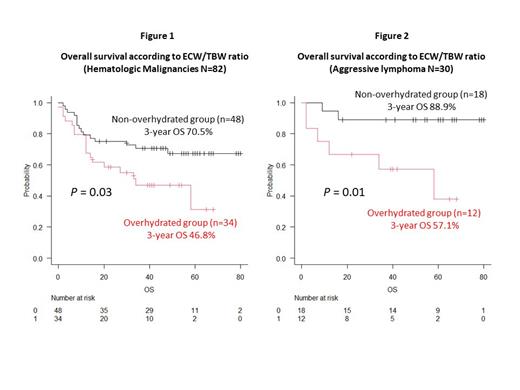[Introduction] Body composition assessment is often used in clinical practice for evaluating and monitoring sarcopenia and nutritional status. Bioelectrical impedance analysis (BIA), which uses the conductivity of the body's intracellular and extracellular fluids to respond to cell and tissue functions, has gradually become widely used in clinical practice because of its non-invasiveness, convenience, and low cost. The ratio of extracellular water to total body water (ECW/TBW) measured by BIA has been found to be related to the prognosis of many diseases, but its application value for patients with hematologic malignancies still needs to be further explored. The purpose of this study was to further explore the application value of ECW/TBW measured by BIA in elderly patients with hematologic malignancies.
[Patients and Methods] We prospectively analyzed 82 elderly patients aged≥60 years with hematologic malignancies diagnosed at our institution between 2015 and 2018. Appendicular skeletal muscle mass (ASM) and ECW/TBW ratio were measured by using multifrequency BIA (InBody 720). In this study, the ECW/TBW cut off value to predict survival was determined by a receiver operating characteristic (ROC) curve analysis. The ECW/TBW ratio cut offs was 0.397 (sensitivity 67.3% and specificity 54.5%, area under the curve (AUC) 0.586, [95% confidence interval (CI) 0.46-0.711]) for all 82 patients. Patients with ECW/TBW < 0.397 were sorted into the non-overhydrated group (NOH-group) and those with ECW/TBW > 0.397 into the overhydrated group (OH-group). Skeletal muscle index (SMI) was defined as the ratio of ASM divided by height in square centimeters. Sarcopenia was defined according to the AWGS2019 algorithm, in which the patient has low muscle mass, and low muscle strength or low physical performance. The study protocol was approved by the Institutional Review Board of Yokohama Municipal Citizen's Hospital, and it was carried out in accordance with the Declaration of Helsinki. This trial was registered in the UMIN clinical trial registry (UMIN000035834).
[Results] Median age at diagnosis was 78 years (60-93 years), with 46 males and 36 females. The diagnosis included non-Hodgkin lymphoma (NHL, n=51), multiple myeloma (MM, n=11), myelodysplastic syndrome (MDS, n=12), and acute myeloid leukemia (AML, n=8). The mean ECW/TBW ratio of all 82 patients was 0.397±0.014. There was no significant difference in the mean ECW/TBW ratio between disease types. Thirty-four patients (41%) were classified as OH-group and 48 patients (59%) were classified as NOH-group. The median age in the OH- and NOH- groups was 83 and 74 years (p<0.001). The mean BMI did not differ between the two groups (22.17 vs. 22.16 kg/m2, respectively, p = 0.99). The prevalence of sarcopenia was 41.4% (34/82). There was no significant difference in overall survival (OS) between the sarcopenia and the non-sarcopenia group (3-year OS, 58.1% vs. 63.3%, p=0.96). On the other hand, patients with OH-group had shorter OS than those with NOH-group (3-year OS, 46.8% vs. 70.5%, p=0.03). We next performed a subgroup analysis of NHL patients. Among 51 NHL patients, 30 (59%) had aggressive lymphoma and 21 (41%) had indolent lymphoma. Twenty patients (39%) were classified as OH-group and 31 patients (61%) were classified as NOH-group. Patients with OH-group had shorter OS than those with NOH-group (3-year OS, 67.1% vs. 90.3%, p=0.02). The prevalence of sarcopenia was 37.3% (19/51) and sarcopenia was not correlated with survival in NHL patients. Among 30 aggressive lymphoma patients, the overhydrated status was closely associated with poor outcome (3-year OS was 57.1% in the OH-group and 88.9% in the NOH-group, p=0.01). On the other hand, there was no significant difference in OS between the OH- and NOH- groups among 21 indolent lymphoma patients. Multivariate analysis showed that the overhydrated status (high-ECW/TBW ratio) was an independent prognostic factor for OS in patients with aggressive lymphoma (HR, 5.30; 95%CI, 1.01-27.7, p=0.04).
[Conclusion] The present study demonstrated that high-ECW/TBW ratio was associated with poor outcome in elderly patients with hematologic malignancies. Especially, the overhydrated status was closely associated with poor outcome in elderly aggressive lymphoma patients. Since our results are based on a small-sized analysis, further large prospective studies are warranted to verify this conclusion.
Disclosures
No relevant conflicts of interest to declare.


This feature is available to Subscribers Only
Sign In or Create an Account Close Modal